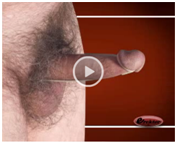Abdominal
distension and prominent wrinkling of the abdominal skin are characteristic of
prune belly syndrome. Although the underlying pathophysiology is enigmatic,
distension of the abdomen associated with distension of the urinary bladder is
present in all cases. (From
MacLennan GT, Cheng L: Atlas of Genitourinary Pathology. London,
Springer-Verlag, 2011.)
In the classic form of prune belly
syndrome, the bladder appears distended, and there is bilateral hydroureteronephrosis.
It is unclear whether failure of bladder emptying is a mechanical or a
physiologic problem. Mechanical obstructions may include posterior urethral valves,
urethral diaphragm, urethral stenosis, atresia or multiple lumina; or the
bladder neck may be incompetent, forming a flap-like valve. When seen at autopsy,
the bladder is not always massively distended and thin-walled. After decompression,
it may be small or normal-sized but markedly thick-walled; in such cases,
bilateral upper tract distension and renal abnormalities are readily apparent nonetheless.
(From MacLennan GT, Cheng L: Atlas
of Genitourinary
Pathology. London, Springer-Verlag, 2011.)





